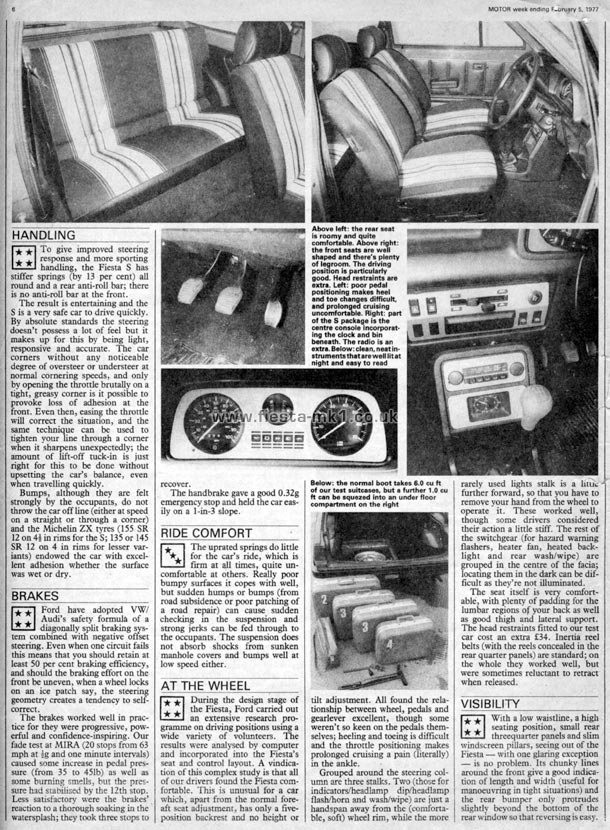Copy of Article Text Below
HANDLING
To give improved steering response and more sporting handling, the Fiesta S has stiffer springs (by 13 per cent) all round and a rear anti-roll bar; there is no anti-roll bar at the front.
The result is entertaining and the S is a very safe car to drive quickly. By absolute standards the steering doesn't possess a lot of feel but it makes up for this by being light, responsive and accurate. The car corners without any noticeable degree of oversteer or understeer at normal cornering speeds, and only by opening the throttle brutally on a tight, greasy corner is it possible to provoke loss of adhesion at the front. Even then, easing the throttle will correct the situation, and the same technique can be used to tighten your line through a corner when it sharpens unexpectedly; the amount of lift-off tuck-in is just right for this to be done without upsetting the car's balance, even when travelling quickly.
Bumps, although they are felt strongly by the occupants, do not throw the car off line (either at speed on a straight or through a corner) and the Michelin ZX tyres (155 SR 12 on 4£ in rims for the S; 135 or 145 SR 12 on 4 in rims for lesser variants) endowed the car with excellent adhesion whether the surface was wet or dry.
BRAKES
Ford have adopted VW/Audi's safety formula of a diagonally split braking system combined with negative offset steering. Even when one circuit fails this means that you should retain at least 50 per cent braking efficiency, and should the braking effort on the front be uneven, when a wheel locks on an ice patch say, the steering geometry creates a tendency to self-correct.
The brakes worked well in practice for they were progressive, powerful and confidence-inspiring. Our fade test at MIRA (20 stops from 63 mph at ig and one minute intervals) caused some increase in pedal pressure (from 35 to 451b) as well as some burning smells, but the pressure had stabilised by the 12th stop. Less satisfactory were the brakes' reaction to a thorough soaking in the watersplash; they took three stops to recover.
The handbrake gave a good 0.32g emergency stop and held the car easily on a l-in-3 slope.
RIDE COMFORT
The uprated springs do little for the car's ride, which is firm at all times, quite uncomfortable at others. Really poor bumpy surfaces it copes with well, but sudden humps or bumps (from road subsidence or poor patching of a road repair) can cause sudden checking in the suspension and strong jerks can be fed through to the occupants. The suspension does not absorb shocks from sunken manhole covers and bumps well at low speed either.
AT THE WHEEL
During the design stage of the Fiesta, Ford carried out an extensive research programme on driving positions using a wide variety of volunteers. The results were analysed by computer and incorporated into the Fiesta's seat and control layout. A vindication of this complex study is that all of our drivers found the Fiesta comfortable. This is unusual for a car which, apart from the normal fore-aft seat adjustment, has only a five-position backrest and no height or tilt adjustment. All found the relationship between wheel, pedals and gearlever excellent, though some weren't so keen on the pedals themselves; heeling and toeing is difficult and the throttle positioning makes prolonged cruising a pain (literally) in the ankle.
Grouped around the steering column are three stalks. Two (those for indicators/headlamp dip/headlamp flash/horn and wash/wipe) are just a handspan away from the (comfortable, soft) wheel rim, while the more rarely used lights stalk is a lit tic -further forward, so that you have to remove your hand from the wheel to operate it. These worked well, though some drivers considered their action a little stiff. The rest of the switchgear (for hazard warning flashers, heater fan, heated backlight and rear wash/wipe) are grouped in the centre of the facia; locating them in the dark can be difficult as they're not illuminated.
The seat itself is very comfortable, with plenty of padding for the lumbar regions of your back as well as good thigh and lateral support. The head restraints fitted to our test car cost an extra £34. Inertia reel belts (with the reels concealed in the rear quarter panels) are standard; on the whole they worked well, but were sometimes reluctant to retract when released.
VISIBILITY
With a low waistline, a high seating position, small rear threequarter panels and slim windscreen pillars, seeing out of the Fiesta - with one glaring exception - is no problem. Its chunky lines around the front give a good indication of length and width (useful for manoeuvring in tight situations) and the rear bumper only protrudes slightly beyond the bottom of the rear window so that reversing is easy......
Captions -
Top - Above left: the rear seat is roomy and quite comfortable. Above right: the front seats are well shaped and there's plenty of legroom. The driving position is particularly good. Head restraints are extra. Left: poor pedal positioning makes heel and toe changes difficult, and prolonged cruising uncomfortable. Right: part of the S package is the centre console incorporating the clock and bin beneath. The radio is an extra. Below: clean, neat instruments thatare well lit at night and easy to read
Middle - Below: the normal boot takes 6.0 cu ft of our test suitcases, but a further 1.0 cu ft can be squezed into an under floor compartment on the right
|







